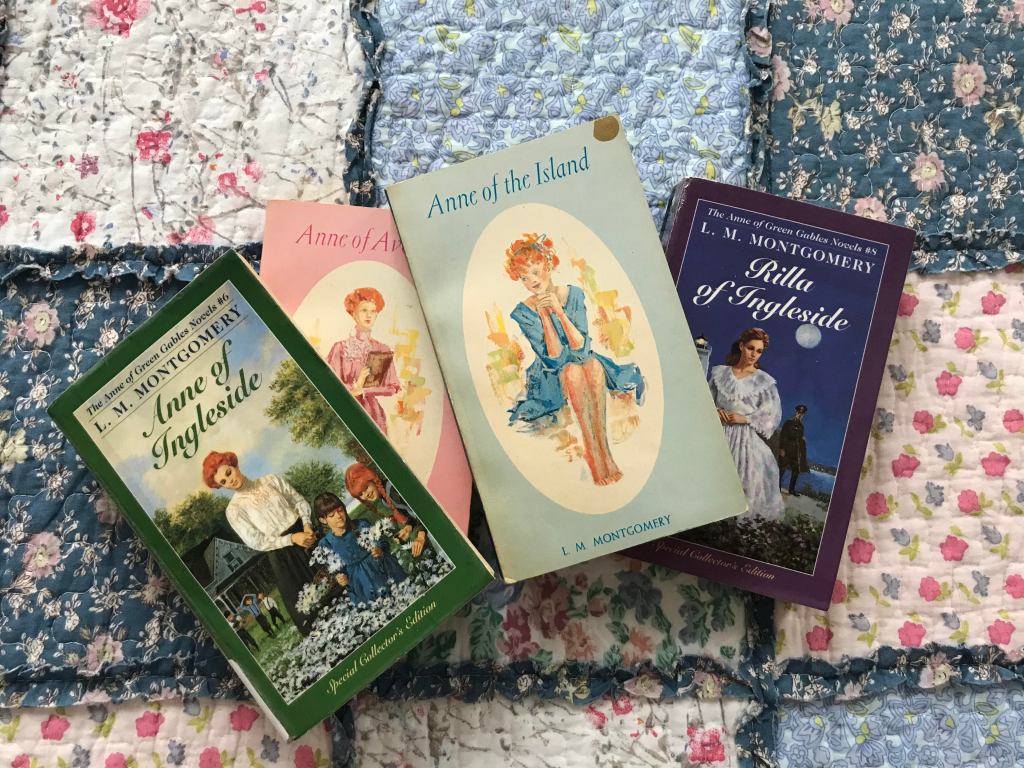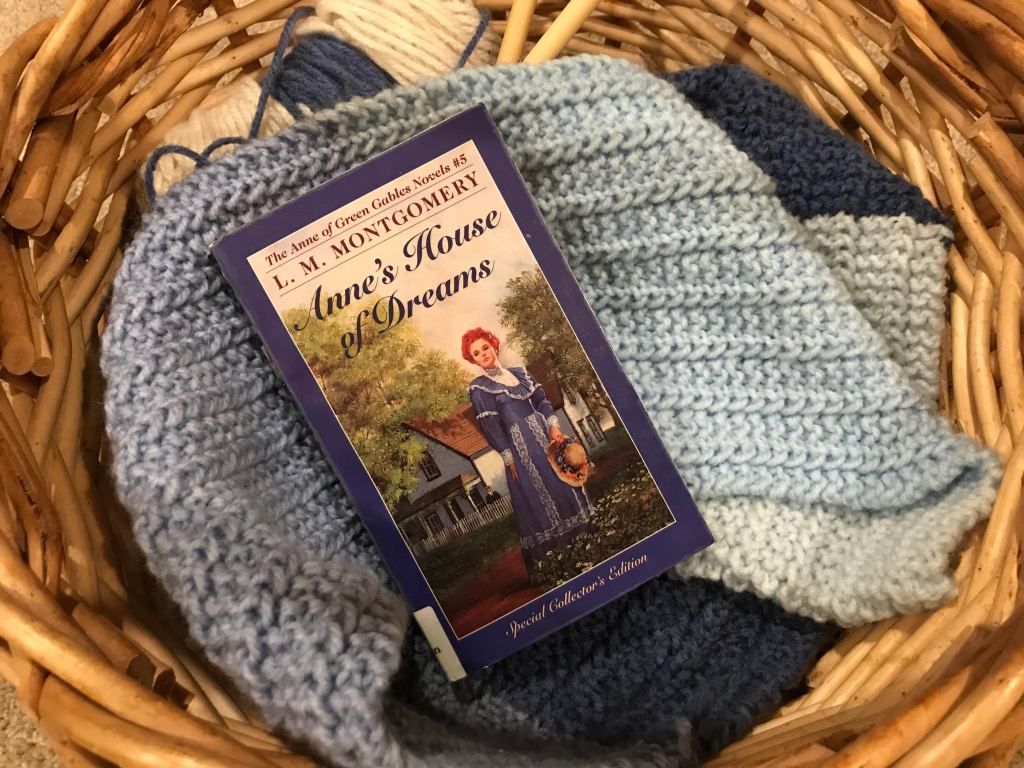My childhood schoolhouse in the mountains of Maine crested a pine-covered rise. Railroad ties ringed our hilltop playground to prevent hapless students from tumbling over the precipice. Our imaginations transformed those railroad ties into the stage for countless reenactments of Anne Shirley’s ridgepole-walking stunt. Whichever girl was unfortunate enough to play the goading Josie Pye in this tableau automatically received the coveted role of Anne as waterlogged lily maid in the next.
How many years of my childhood were spent in Avonlea I dare not guess, but I will say that despite considering Anne a bosom friend, conducting my own Story Club, and weeping quarts over Matthew, I never actually read the entire series. I would trudge along until Anne arrived at Windy Poplars, find myself missing the folks back in Avonlea, and ultimately fail to recapture my wandering attention.
But in the throes of pandemic isolation, I decided to give Anne another go. After all, what else did I have to do? Until I read Anne of Green Gables from the vantage point of motherhood, I never suspected the novel is as much the story of Marilla’s redemption as Anne’s coming of age. Marilla appears on the scene as “a woman of narrow experience and rigid conscience,” yet even at the beginning “there was a saving something about her mouth which, if it had been ever so slightly developed, might have been indicative of a sense of humor.” Who better to help Marilla develop humor than Anne, with her enormous capacity for mishaps, affection, and delight?
But Anne unleashes something more profound than Marilla’s sense of humor: “The lesson of a love that should display itself easily in spoken word and open look was one Marilla could never learn. But she had learned to love this slim, gray-eyed girl with an affection all the deeper and stronger from its very undemonstrativeness.” Marilla conquers even this hardest of all lessons when tragedy shadows sunny Green Gables. “It’s never been easy for me to say things out of my heart, but at times like this it’s easier. I love you as dear as if you were my own flesh and blood…” she tells Anne.

Buoyed by fresh insight, I sallied onward. Anne stretches her wings in Anne of the Island, leaving Green Gables for her college course at Redmond, but she visits the folks back home in Avonlea often enough to satisfy me. On the brink of adulthood, Anne’s idealism suffers a jarring blow from ridiculous marriage proposals, not to mention the Rollings Reliable story humiliation. Anne mourns, “The bloom had been brushed from one little maiden dream. Would the painful process go on until everything became prosaic and hum-drum?” But surely this painful process allows her to relinquish visions of “sunbursts and marble halls” so she can accept the unromantic but eminently satisfying Gilbert.
This brought me to Windy Poplars where my readerly ambition gave out so many times before. I yearned to know more. How did Anne and Gilbert’s courtship progress? How did they weather the early days of marriage? And from reading the back of the books, I knew Anne ends up with six children. How did scatterbrained Anne manage such a household?
As I eagerly rifled pages, I couldn’t help wailing, “Where is Gilbert?!” Anne’s voluminous letters to the dashing young man proved little comfort to me. But surely things would get better after they actually got married and lived together in their House of Dreams. Well, there’s one little catch. Gilbert, busy doctor that he is, constantly finds himself out on house calls. Okay, but when he is home, couldn’t he have the good grace to at least be in the room? Oh no, he’s mostly hiding in his study with the door cracked open so he can chuckle at Miss Cornelia’s gossip. Well, she certainly could talk the hind leg off a mule, so who could blame him?
Sobered by this letdown, I warily cracked open Anne of Ingleside – wait, perhaps I should say Anne Away from Ingleside! Like all the books after Anne of the Island, the story focuses on Anne’s friends and children rather than on Anne herself. But whenever friends come to call at Ingleside, and I dared hope for a glimpse of Anne, I was astonished to learn that she had just stepped out to visit a neighbor, or gad off to Avonlea, or run a Ladies’ Aid Society meeting. Her friends make themselves quite at home in her absence, settling in for colorful chats with Susan the housekeeper or Miss Cornelia – who seems to reside at Ingleside more than our heroine.

A terrible suspicion haunted me. Had L.M. Montgomery allowed Anne to escape from her own story because she could envision no further development once motherhood thwarted Anne’s early ambitions? What happened to the Anne who believed that “all the Beyond was hers with its possibilities lurking rosily in the oncoming years?” Did she ever feel pangs of regret over the lost teaching career she studied for so earnestly? And what in the world about her writing? Couldn’t she at least scribble a few lines in the gloaming after tucking the children in?
At last I had to ask myself why I was getting so worked up about Anne. Could it be that I identified too closely with her fall from idealism? I was never a romantic child like Anne – I grew up with too much New England practicality to put much faith in fairy tales. But, like Anne, I spent my childhood writing stories and dreaming of what I would be one day. I thought by now I would have published novels, earned a PhD, succored widows and rescued orphans.
But here I am, living a perfectly lovely but sometimes frighteningly ordinary life. For a moment, I wonder if I allowed reality to sabotage all the studious hours, the ambitions, the faith my loved ones placed in me to make something of my life. Then understanding hushes my tortured ponderings. Anne never grew disillusioned; she simply came to peace beautifully with her own scope and limitations. Comparing her gift to her student Paul Irving’s genius, she admits with no bitterness that she will only ever write small, pleasant pieces for children. She chooses not to spend her life wrestling with what-might-have-beens.
A hint of Anne’s ability to reconcile herself to her life’s boundary lines comes even before she tries her wings. When Anne postpones her dream of studying at Redmond in order to save Green Gables, she asserts, “I’m just as ambitious as ever. Only, I’ve changed the object of my ambitions. I’m going to be a good teacher.” Perhaps it’s no surprise, then, that when marriage signals the end of her teaching career, she shifts her ambition once more. How amply her rich education, vibrant imagination, and propensity for kindred spirit relationships equipped her for motherhood! And time after time, Anne warms the lives of the simple townsfolk she befriends just as she illuminated Marilla’s dreary spinsterhood. The declaration Anne makes at the end of Green Gables becomes her ruling precept in all the places she calls home thereafter: “I shall give my life here my best, and I believe it will give its best to me in return.”
L.M. Montgomery didn’t purposefully write Anne out of her novels, as if she had grown ashamed of her erstwhile heroine’s lackluster performance. No, the Anne series unapologetically champions the worth of simple, ordinary life. As we grow up, reality unavoidably tempers our ideals. A few people rise to fame, publish novels, or save at least small corners of the world, but most of us exchange childhood for quotidian adulthood. None of us is as much the heroine, or even the main character, of our own stories as we would like to believe. And yet, therein lies the beauty and the promise. In focusing on the small-town life percolating all around Anne, Montgomery affirms that the beauty and joy of life isn’t in our accomplishments but in the friends who solace our lives and whose lives we brighten in return.

I find my thoughts turning to Anne often as I pick up soggy Cheerios underneath the table, or expostulate times without number that 1+1 does indeed equal 2, or hear the thud of feet on the stairs impossibly early in the morning when I’ve just poured myself a cup of tea. I hope you’ll think of her often too and feel a little sacred glow hallowing all your mundane moments. (Oh, and when you do manage to scavenge a second for tea, be sure to read Rilla of Ingleside. Suddenly life becomes anything but ordinary and even the simplest characters wax heroic. It’s heartbreaking and wonderful, and I know you’ll love it!)

This was such an intriguing observation and connection with L.M. Montgomery’s own life experience (or lack thereof). I’ve been rereading the series and also find myself impatient with all the new characters and side plots. I blame that partly on the movies since they stick to the Anne threads pretty closely. I’m Sara’s friend and I love your blog. I used to write things like this and may pick it up again!
LikeLike
Thanks for reading and for your kind words! Yes, I think you’re right that the movies (which I love, at least the Kevin Sullivan ones) have changed how we experience the books. I hope you will start writing again; I’m finding I get so much more out of a book when I write and share about it!
LikeLike
I just finished Anne of Ingleside and you’re right, she’s hardly in it at all! It opens up in such a lovely way with Anne back at Avonlea reliving old times with Diana, and it closes nicely with Gilbert and Anne enjoying each other like old times, but they hardly make an appearance for the rest of the book (except for the frequent references to Anne’s loving arms and comfortable maternal presence when the children are in distress). Susan, the housekeeper, seems to be more of a mother and wife than Anne. She’s always the one cooking extra special things for hard-working Gilbert and leaping up to get him his lemonade when he returns from work. She looks after the children more than Anne, cooks all the meals, cleans, and even does the spinning in the garret! It was cute reading about the children and one could see bits of Anne in each of them but it seemed like this book didn’t belong in the series. It’s still a good story though! I love your commentary on the series 🙂
LikeLike
I know, it seemed like Anne spent most of her time wandering in her flower garden while Susan held the home together in a lot of ways. But I like what you said about Anne showing up in each of her children – maybe that’s where she’s hiding! Susan really comes into her own in Rilla of Ingleside; I think she’s my favorite character by the end of the series.
LikeLike